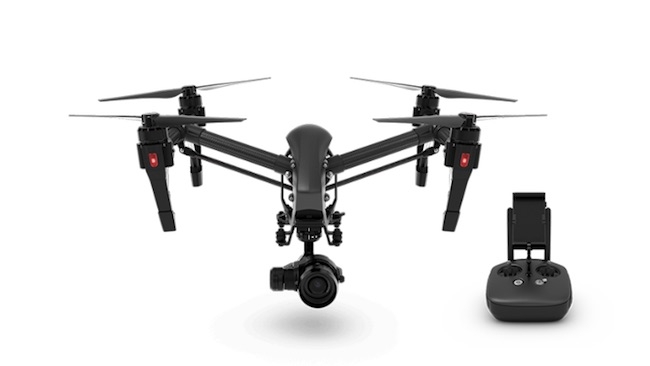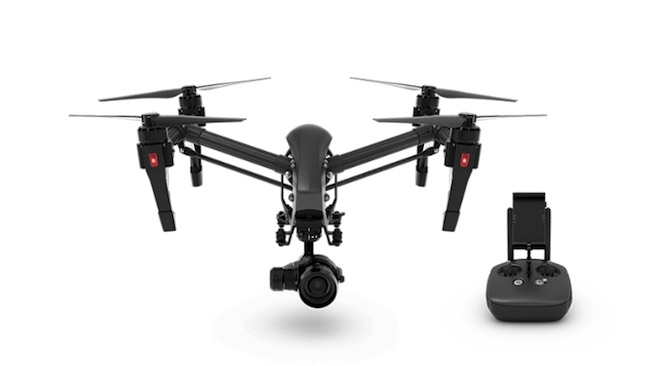
 None more black: the new Inspire 1 Pro Black Edition
None more black: the new Inspire 1 Pro Black Edition
DJI is wasting no time with its New Year news with the announcement of the €899 Phantom 3 4K, an Inspire 1 Pro Black Edition, a new SDK, and a public beta of a new geofencing system.
DJI claims that the new 4K Phantom model fills an important gap in its lineup. So, what’s new and different?
The new Phantom weighs in the same as the Phantom 3 Standard, and is therefore slightly lighter than the Advanced and Professional editions. In terms of features the new 4K model seems to be placed precisely between the Advanced model and the Standard one.
Like the Standard aircraft, and unlike the Advanced version, the new 4K model has GPS only (no GLONASS), although it does retain the Vision Positioning System, which allows effective indoors flight to take place without the need for satellite reference.
The new 4K drone appears to be using the same camera as the Professional edition, with all the same shooting modes available as that model, which curiously makes the new aircraft more capable visually than the Advanced version.
Unlike the Advanced aircraft the new one has cut costs by ditching the Lightbridge system to transmit video back to the ground station, and instead uses a WiFi downlink. This restricts the transmittable distance down to 1200m compared to the 5000m of the Lightbridge system. Although it is still higher than the Phantom 3 standard, and uses the same 2Mbps transmission bitrate as the Advanced aircraft, but reduced to 480p resolution.
So, who will the Phantom 3 4K be suitable for? I have no doubt that some people may opt for it instead of the Advanced model in some cases. If the realtime preview transmission distance isn’t so important to you, but you need 4K and don’t have the money for the Professional edition, then the new 4K model will be the one to go for. On paper at least.
In addition to the Phantom 3 4K DJI has also released the Inspire 1 Pro Black Edition. It does look rather good it has to be said, as it shold for €5299, although pinpointing it in the sky could be harder. All other specs on the new Black model remain the same as the existing Inspire 1 Pro.
DJI has also announced a new SDK 3.0 Suite. The new SDK has been totally re-written and supports all of their RTF drone range from the Phantom 3 up to the Matrice 100, as well as their camera systems such as the X5 and Osmo stabiliser.
Welcome additions include more control over the camera gimbal, flight status systems and flight control data. They have also implemented a one time application and allowed an unlimited installation quote, which should make life a lot easier.
As well as that there is now more control allowed over the ability to create custom missions. This should open the doors for ever more in depth mapping control software for instance.
As to the geofencing, the restrictions that prevent DJI drones from taking off and flying in certain restricted areas have been the bane of many pilots’ lives. But now the company has taken note of user frustrations and started to implement an override system.
Geofencing is, on the whole, a very good idea. It prevents some of the more, shall we say, adventurous fliers out there from flying their drone right into the path of a landing 777 at Heathrow for example. When it comes to many airports and military installations DJI drones will simply not take off.
This is fantastic for the safety of the general public. But for professional pilots it can place undue restrictions on things. Anyone with a Permission For Aerial Work in the UK knows to contact ATC or other relevant people when flights are planned near restricted areas or by airfields. It is part of our risk assessment, and a matter of course for procedure. And because we are aware of the safe distances required, and the relevant people in authority to contact, such blanket restrictions built in to the drone can mean having to pass on work.
On top of this, sometimes flights may be taking place indoors, and yet the drone will still be prevented from taking off due to its GPS location.
DJI’s new Geofencing solution is not a blanket permission to fly in any area you like. Restrictions still apply, but by registering, pilots can self authorise their aircraft temporarily to fly in a specific location if required. There are still limitations, for example you will never be able to fly over an area such as GCHQ or The White House or other sensitive places.
The system is currently in public beta, but expect it to be rolled out fully in due course.
RedShark Sound is coming soon. Don't miss the launch - sign up here for updates and a chance to win one of 5 iZotope RX5 Audio Editors.
Tags: Production


Comments